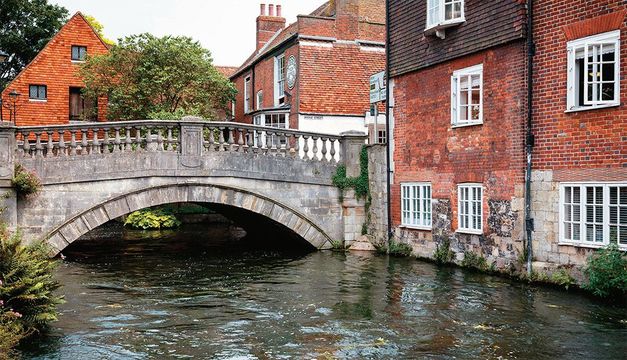

Wessex by Rail
It was indeed the Saxon kingdom of Dark-Age England’s most famous king. Later, the great late Victorian novelist Thomas Hardy set his brooding novels of raw rural life in a fictional Wessex. Today, Alfred the Great and Hardy’s Wessex stretches over Hampshire, Wiltshire, Dorset and Somerset—a rich tapestry of scenic landscapes and ancient history easily accessible from London. Take a ride on the rails with this train journey through Wessex, with stays in some of England’s most history small cathedral cities. Most conveniently, take the trip with a Britrail Pass, letting you hop on and hop off any train at will.
Day 1 To the Kingdom of Alfred the Great
It’s a journey of no more than an hour from London Waterloo southwest across the rolling hills of Hampshire to the ancient Saxon capital of Winchester. Alfred the Great’s statue still looks down over the High Street. Nearby, visit the Tourist Information Centre (TIC) in the Guildhall for local street maps and brochures. You won’t get lost in Winchester, however; it’s a small, compact city. Winchester Cathedral is the undoubted highlight, with the longest medieval nave in Europe, and centuries of history. The cathedral close is perhaps the most delightful in England. Walk up the High Street to the Great Hall of Winchester Castle. No, that’s not really King Arthur’s roundtable on the wall. Winchester’s acclaimed military museums are just next door. Down by the River Itchen, visit the old city mill, or take a walk through the water meadows to St. Cross Hospital to get the Wayfarer’s Dole of bread and ale.
With an intimate city center and dining options of every variety,Winchester makes a hospitable stay of a couple of nights. The Royal Hotel is a classic 3-star town hotel; the modern Wessex Hotel sits right in the cathedral close.
Day 2 At Home with the Royal Navy
Take an excursion to Portsmouth today. It’s a short train ride from Winchester to the harbor home of Britain’s Royal Navy. All the buzz just now is on the new £35 million museum home for Henry VIII’s flagship Mary Rose, the only 16th-century warship on display anywhere in the world. Check out too, HMS Warrior, the world’s first ironclad screw-prop battleship, and much more in Portsmouth’s great Naval Museum. There’s certainly much more to Portsmouth than the Royal Navy. Head for the Spinnaker Tower and ascend for phenomenal views over the city, the Solent and the Isle of Wight. Pay a visit to Charles Dickens’ birthplace, or head east along Southsea beach for a visit to the poignant D-Day Museum, on the 70th anniversary of Operation Overlord.
Return trains to Winchester are easy to come by anytime in the afternoon. In the evening, you might return to a now favorite pub or try one of the many great cafes on the High Street and clustered around the cathedral close.
Day 3 Toodle on to Purpose-Built 13th-Century Salisbury
You might as well let the morning commuter train traffic clear; it’s less than an hour’s train journey west into Wiltshire and the 13th-century cathedral city of Salisbury. Unlike most medieval cathedral cities, Salisbury’s dating is clear. In 1225 Bishop Richard Poor won permission to relocate the ancient cathedral from the upland plains of Old Sarum down to the river valley. The new cathedral was built in a generation and the old cathedral dismantled to be rebuilt as the close walls of the new—the largest cathedral close in Britain. Naturally, the city followed. And medieval Salisbury is apparent in the old streets that radiate from the 700-year-old cathedral. Don’t miss a visit to the elegant Mompesson House in the close and enjoy exploring the purpose-built medieval city.
Salisbury has several classic 3-star inns all worth a treat: the White Hart or the Red Lion. Or just across the river in Harnum, the Rose & Crown, where all the rooms look out across the water-meadow in John Constable’s famous view of Salisbury Cathedral.
Day 4 Where Jane Austen Meets the Romans
Catch a train today to Bath; you may have to change at Bristol Temple Meads, but it’s an easy connection and a short journey. From Bath Spa Station, the abbey and central city lie straight ahead about three blocks down Manvers Street. Again, make your first stop the Visitors Centre in the Abbey Courtyard. Bath is one of England’s most popular destinations with visitors from around the world, and the city is well-equipped to provide hospitality to all.
Once you’ve settled into accommodation, if it’s a first visit to Bath, you really can’t get a better introduction to Bath’s history, attractions and geography than taking a guided tour of the city in a double-decker bus. Catch one on the Grand Parade in front of Parade Gardens. In nice weather, sit on top for the best views—and photos.
Day 5 What to Do, What to Do in Bath
Conveniently, our “Day Well Spent,” overleaf, is a great place to start planning. It is no secret that Bath would take a week to thoroughly explore. The Royal Crescent, The Circus, Pulteney Bridge and The Pump Room are not to be missed. Bath is also a popular shopping city. The elegant pedestrian precinct and Milsom Street were great shopping centers even in Jane Austen’s day.
Day 6 The Easy Return to London
From Bath Spa Station, there are frequent trains for the hour-long journey in to London Paddington. From London Paddington, the Heathrow Express can have you quickly at the airport. Of course, all of London awaits as well. With a few more days, you might take the train over to Bristol or across south Wales to Pembrokeshire.





Comments